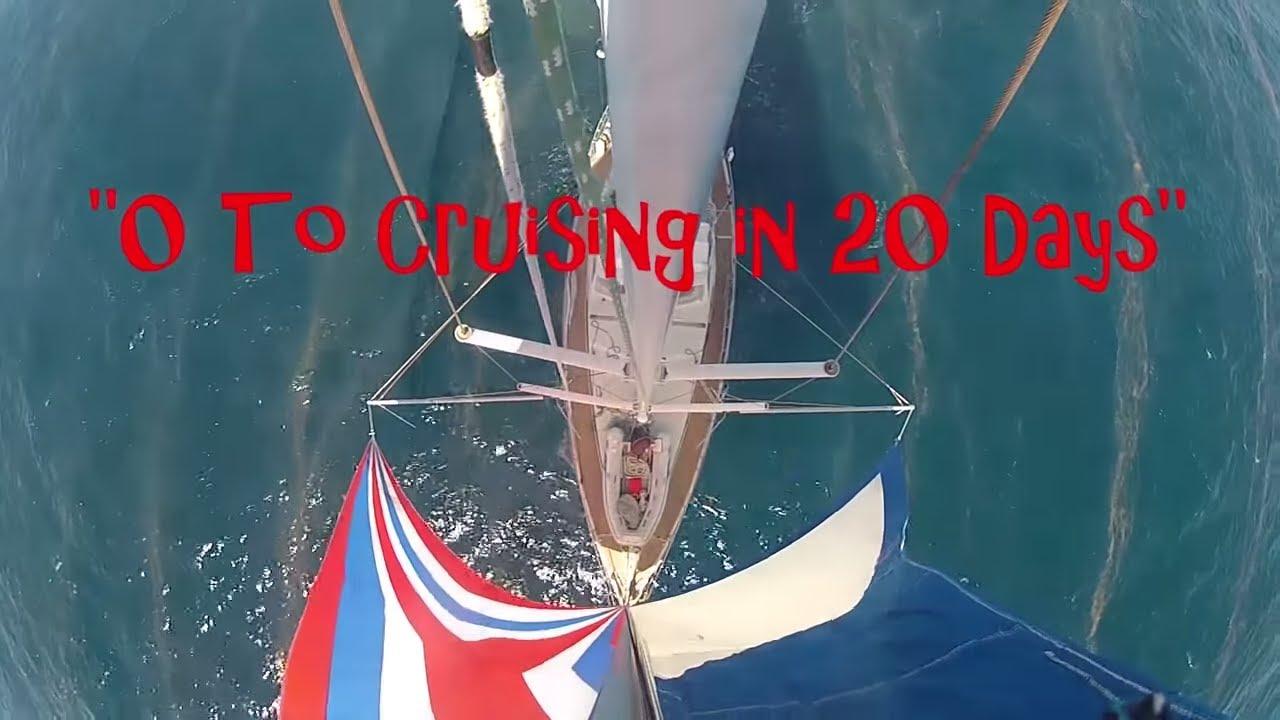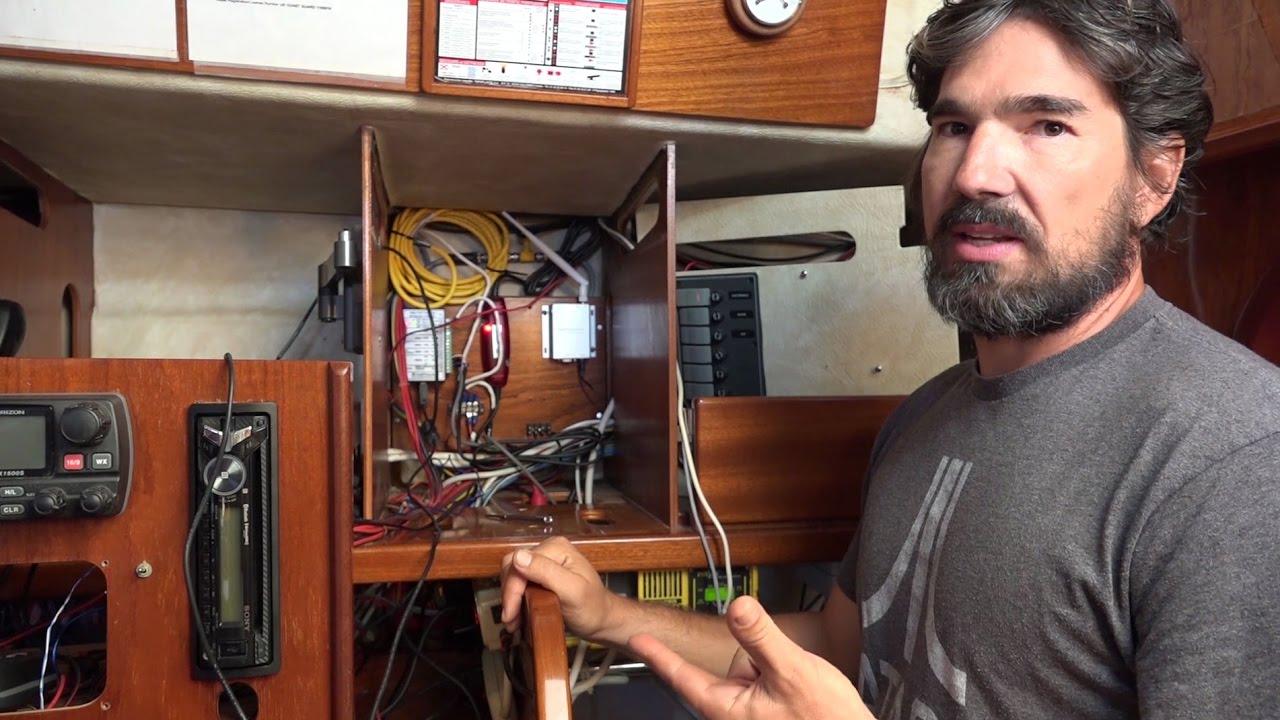In the YouTube video titled ""0 to cruising in 20 days"- Sailing SV Delos Ep. 15," the crew of the sailing boat Delos documents their journey from leaving the boat for almost a year to returning and preparing it for cruising once again. The narrator expresses initial fears about potential damage caused by rain, dead batteries, and the aftermath of a cyclone. However, to their surprise and relief, the boat’s exterior and interior were in good condition upon inspection. The crew also worked on the thruster and inspected the propeller while Delos was on land. They witnessed the process of the boat being lifted and moved by large machines, eventually being placed back in the water. Despite feelings of guilt for leaving the boat unattended for so long, the crew is excited to have Delos back in its element and ready for new adventures.
Heading 1: Returning to Delos after a year: Concerns and Surprises
After 27 hours of flying, I’m back home on Delos. I was quite scared at that moment. I had left it all alone for almost a year and I was afraid that the rain had gotten inside or that the batteries were dead or that the damn cyclone had broken something. You have no idea what can happen when you leave your boat for a long time.
In fact, the city of Bunderberg had experienced terrible floods earlier this year. Many boats were carried away by the river and destroyed. The mid-town Marina, one of the options for storing Delos, was completely flooded under a torrent of water. Luckily, I had chosen the Bunderberg Port Marina, which was a bit more expensive but less affected. After confirming that the exterior was in good condition, it was time to check the interior. I was really afraid that the batteries and solar panels were dead. I had heard so many stories about people leaving their boats and coming back to find them filled with water and mold. You know, a real mess inside. Like coming home after a vacation and seeing a hole in the roof with water inside and all your belongings ruined.
But no, in fact! It was really spotless! Everything was exactly as we had left it. The voltage was good and the batteries were charged. It was the best surprise. The only water inside was in the aft locker where the cyclone rains had seeped in. This made Delos a home for a new crew member. While Delos was out of the water, I spent a few long days working on the bow thruster and inspecting the propeller. Things that are easier to do when the boat is on land.
But at one point, men with big machines appeared to lift the boat from its cradle and put it back in its element – the ocean. They tapped and hammered to slowly free it from its supports, one by one, until it was suspended only by two nylon straps. With a few nods, it slowly made its way toward the ocean. It’s so incredible to see a 53-foot, 20-ton boat being moved with this strange contraption.
They moved Delos on roads, through gates, and finally onto a precarious jetty before lowering it 6 meters down into the river. While Delos was returning to the water, I couldn’t help but feel a little sorry for it, for leaving it empty, alone, and dry for so long. It needed a fresh start, and I was determined to make it happen.
Heading 2: Assessing the condition of Delos: Interior and Exterior Check
After 27 hours of flying, I’m back home, on Delos. I was quite scared at that moment. I had left it all alone for almost a year and I was afraid that the rain had gotten inside or that the batteries were dead or that the damn cyclone had broken something. You have no idea what can happen when you leave your boat for a long time. In fact, the city of Bunderberg experienced terrible floods earlier this year. Many boats were washed away by the river and destroyed. The mid-town Marina, one of the options for putting Delos in storage, was completely flooded with water. Luckily, I had chosen Bunderberg Port Marina, which was a bit more expensive but less affected.
After confirming that the exterior was in good condition, it was time to check the interior. I was really afraid that the batteries and solar panels were dead. I had heard so many stories about people leaving their boats and coming back to find them filled with water and mold. You know, a real mess inside. Like coming home after a vacation and seeing a hole in the roof with water inside and all your belongings ruined. But no, actually! It was really clean! Everything was exactly as we had left it. The voltage was good and the batteries were charged. It was the best surprise. The only water inside was in the aft locker where the cyclone rains had seeped in, which made Delos a home for a new crew member. While Delos was out of the water, I spent a few long days working on the bow thruster and inspecting the propeller. These are things that are easier to do when the boat is on land. But at one point, men with heavy machinery appeared to lift the boat off its cradle and put it back in its element: the ocean. They banged and hammered to slowly release it from its supports, one by one, until it was suspended only by 2 nylon straps. With a few nods, it slowly headed towards the ocean. It’s so incredible to see a 53-foot, 20-ton boat being moved with this strange contraption. They moved Delos on roads, through gates, and finally onto a precarious jetty before lowering it 6 meters down into the river. While Delos was returning to the water, I couldn’t help but feel a little sorry for leaving it empty, alone, and dry for so long. It needed some
Heading 3: Maintenance and Upgrades while Delos is out of water
After 27 hours of flying, I am back home, on Delos. I was quite scared at that moment. I had left it all alone for almost a year, and I was afraid that the rain had come in or that the batteries had died or that the damn cyclone had broken something. You have no idea what can happen when you leave your boat for a long time. In fact, the town of Bunderberg experienced terrible floods earlier this year, and many boats were carried away by the river and destroyed. The mid-town Marina, one of the options for storing Delos, was completely flooded under a torrent of water.
Luckily, I had chosen the Bunderberg Port Marina, which was a bit more expensive but less affected. After confirming that the exterior was in good condition, it was time to check the inside. I was really afraid that the batteries and solar panels had died. I had heard so many stories about people who leave their boats and come back to find them filled with water and mold. You know, a real mess inside. Like coming home after a vacation and seeing a hole in the roof with water inside and all your belongings ruined.
But no, actually! It was really clean! Everything was exactly as we had left it. The voltage was good and the batteries were charged. It was the best surprise. The only water inside was in the rear locker where the cyclone rains had seeped in, which made Delos a home for a new crew member. While Delos was out of the water, I spent a few long days working on the bow thruster and inspecting the propeller. Things that are easier to do when the boat is on dry land. But at one point, men with big machines appeared to lift the boat off its cradle and put it back in its element, the ocean. They tapped and hammered to slowly release it from its supports one by one until it was hanging only by 2 nylon straps. With a few nods, it slowly moved towards the ocean. It’s so incredible to see a 53-foot, 20-ton boat being moved with this strange contraption.
They moved Delos on roads, through gates, and finally onto a precarious dock before lowering it 6 meters down into the river. While Delos was returning to the water, I couldn’t help but feel a little sorry for leaving it empty, alone, and dry for so long. It needed some maintenance and upgrades during this time out of the water. But soon, Delos would be cruising again, ready for new adventures on the open sea. l’amour de son équipage et du plaisir de naviguer. Mais maintenant, alors qu’il retrouve son élément naturel, je suis rempli de joie et d’excitation pour les aventures à venir.
Je suis reconnaissant que Delos ait survécu à toutes les épreuves de cette période d’absence. La marina où il était en garde était la bonne décision, car il n’a pas été touché par les inondations dévastatrices. L’intérieur du bateau était en parfait état, sans aucun signe de dommages ou de moisissure. Les batteries étaient chargées et tout fonctionnait comme il se doit. J’étais soulagé de voir que ma peur était infondée.
Pendant que Delos était hors de l’eau, j’ai saisi l’occasion pour effectuer quelques réparations et inspections. Travailler sur le propulseur d’étrave et l’hélice était plus facile à terre, et j’ai passé de longues journées à m’assurer que tout était en ordre.
Voir Delos être soulevé et déplacé par ces machines massives a été un spectacle fascinant. Le voir flotter à nouveau dans l’océan était une image dont je ne me lasserai jamais. Malgré les défis et les doutes qui ont accompagné cette période d’absence, tout s’est parfaitement déroulé.
Maintenant, je suis prêt à reprendre les voyages avec Delos. Nous partirons bientôt vers de nouvelles destinations et des aventures passionnantes. Mon amour pour la voile et cette belle communauté de voileurs ne cesse de grandir.
J’espère que cet article vous a donné un aperçu de mon voyage et de mes réflexions sur le retour à bord de Delos. N’hésitez pas à regarder la vidéo pour voir toutes les images époustouflantes du processus de remise à l’eau de Delos.
Restez à l’écoute pour de nouvelles mises à jour et de nouveaux récits de nos aventures en mer. Merci de votre soutien continu et de votre intérêt pour notre voyage à bord de Delos. À bientôt !



